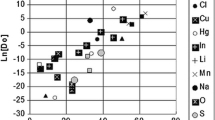Abstract
The chemical diffusion coefficient for a p-type oxide either pure or doped with an aliovalent impurity as evaluated from electrical conductivity changes in simulated relaxation experiments is compared with the corresponding theoretical values obtained on the basis of Fick's first law using a convenient model to represent the defect structure of the oxide. It is found that if the relaxation process is purely diffusion controlled, the experimental value of\(\tilde D\) obtained (\(\tilde D_\sigma \)) is in rather good agreement with the theoretical value calculated by considering the diffusion of lattice defects\(\tilde D\) rather than with that obtained by considering the diffusion of the prevailing electronic defects\(\tilde D_h \), even when the latter two values differ. This is shown to be the result of relatively small departures from a proportionality (for the pure oxide) or from a linear dependence (for a doped oxide) in the relationship between the deviation from stoichiometry δ and the concentration of the electron holes in restricted range of oxygen activity as used in relaxation experiments.
Similar content being viewed by others
References
F. Gesmundo and F. Viani,J. Phys. Chem. Solids 42, 777 (1981).
F. Gesmundo,Solid State Ionics 12, 79 (1984).
F. Gesmundo,Solid State Ionics 13, 21 (1984).
F. Gesmundo,J. Phys. Chem. Solids, to appear.
C. M. Osburn and R. W. Vest,J. Phys. Chem. Solids 32, 1343 (1971).
R. Dieckmann,Z. Phys. Chem. N. F. 107, 189 (1977).
C. R. Catlow, W. C. Mackrodt, M. J. Norgett, and A. M. Stoneham,Phil. Mag. A 40, 161 (1979).
C. R. A. Catlow and A. M. Stoneham,J. Am. Ceram. Soc. 64, 234 (1981).
C. Wagner, inProgress in Solid State Chemistry, J. O. McCaldin and G. Somorjai, eds. (Pergamon Press, New York, 1976), Vol. 10, p. 3.
P. Kofstad,Nonstoichiometry, Diffusion and Electrical Conductivity in Binary Metal Oxides (Wiley-Interscience, New York, 1972).
N. L. Peterson and C. L. Wiley,J. Phys. Chem. Solids, to appear.
J. Nowotny, J. Oblakowski, A. Sadowski, and J. B. Wagner, Jr.,Oxid. Met. 14, 437 (1980).
J. Nowotny and J. B. Wagner, Jr.,Oxid. Met. 15, 169 (1981).
J. Nowotny, J. Oblakowski, A. Sadowski, and J. B. Wagner, Jr.,Oxid. Met. 15, 191 (1981).
F. Gesmundo and F. Viani,J. Electrochem. Soc. 128, 470 (1981).
F. Gesmundo and F. Viani,J. Electrochem. Soc. 129, 622 (1982).
P. E. Childs and J. B. Wagner, Jr.,Heterogeneous Kinetics at Elevated Temperatures, G. R. Belton and W. L. Worrell, eds. (Plenum Press, New York, 1970), p. 269.
G. J. Yurek and H. Schmalzried,Ber. Bunsenges. Phys. Chem. 78, 1379 (1974).
G. J. Yurek and H. Schmalzried,Ber. Bunsenges. Phys. Chem. 79, 255 (1975).
W. Jost,Diffusion in Solids, Liquids, Gases (Academic Press, New York, 1960), p. 57.
G. J. Koel and P. J. Gellings,Oxid. Met. 5, 185 (1972).
J. Crank,The Mathematics of Diffusion (Oxford University Press, Oxford, 1956), p. 45.
F. Viani, V. Dovì, and F. Gesmundo,Oxid. Met. 21, 309 (1984).
F. Morin,Can. Met. Q. 14, 97 (1975).
F. Morin,J. Electrochem. Soc. 128, 2439 (1981).
Author information
Authors and Affiliations
Rights and permissions
About this article
Cite this article
Gesmundo, F., Dovì, V. & Viani, F. Comparison between the apparent chemical diffusion coefficient evaluated from relaxation experiments by means of electrical conductivity changes and the corresponding theoretical value for a pure and doped p-type oxide. Oxid Met 23, 191–206 (1985). https://doi.org/10.1007/BF00659903
Received:
Issue Date:
DOI: https://doi.org/10.1007/BF00659903




